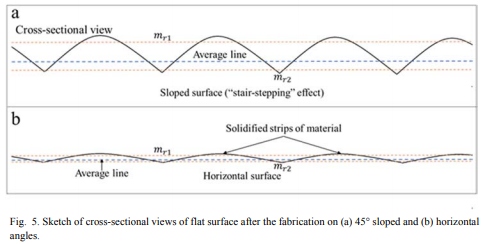Several studies have analyzed the surface finish of 3D printed objects, but very few have looked at the surface finish and dimensional accuracy of those 3D printed through material jetting. Material Jetting is a 3D printing process where a material is jetted from a nozzle usually an inkjet head or similar. This material is then cured by an external light source such as a laser or UV lamp. Objet Polyjet, a Stratasys technology is the major commercialized material jetting technology. Stratasys’ Objet systems produce smooth parts using photopolymers jetted by inkjet print heads and then cured by UV. These parts can even be made into gradient materials with different softness or hardness at different locations. Visually arresting Polyjet parts do have their limitations. Traditionally parts have been brittle and have low heat deflection. Due to this very few studies have been done with the performance of Objet Polyjet parts. Many considered these kinds of parts fine for prototypes but did not see real world end-use part applications. Over the past years, Material Jetting materials have been improved however and the performance of these parts has increased significantly. A new study, “Effect of surface slope and build orientation on surface finish and dimensional accuracy in material jetting processes,” is therefore very timely. In the study, the researchers used a material jetting process to 3D print specimens with a flat area and four feature designs, such as spherical and prismatic holes and protrusions. They were printed in two orientations and scanned with a white-light profilometer to quantify the surface texture, areal, and material ratio parameters for dimensional accuracy and areal fidelity.
“The results indicate that surface slope and build orientation appear to have a greater influence on the recessed features compared to the protruded ones,” the researchers state. “The height and volumetric functional surface parameters are significant and show better surface finish for the 0º surface slope compared to 45º. Also, prismatic and recessed features might benefit from printing on a 45º sloped surface while the design fidelity of cross-sections in holes and protrusions greatly vary depending on the specimen slope. The contributions of this work include illustrating the potential for increased production, resolution and fidelity capabilities if 3D printing equipment could incorporate tilting print trays, adaptable print orientation, and local angles, among others.”
The researchers found that orientation was a statistically significant factor, and that to achieve the minimum self-supporting angle, critical angled faces should be oriented in the YX direction on the build tray.
“Stair-stepping is one of the major artifacts on the printed surfaces due to sloping part features,” the researchers add. “The stairstepping effect happens when a surface orientation is not orthogonal to the axis of the source of energy. This study aims at uncovering the effects of stair-stepping on surface parameters.”
The four features – spherical and prismatic protrusions and holes, as well as a flat area, were fabricated with an Objet30 3D printer, and factorial analyses were performed to observe the effects of the surface slope and build orientation on each of the surface parameters. Broadly, the researchers explain, the height, functional material ratio, and functional volume groups stood out with the most statistically significant parameters.
 Several conclusions were drawn from the study as a whole:
Several conclusions were drawn from the study as a whole:
- The introduction of a surface slope creates stair-stepping which affects different aspects of surface characteristics
- The height and volumetric functional parameters are significant and show better surface finish for the 0° surface slope compared to the 45°
- Build orientation affects the shape and direction of stair-steps
- The orientation that is across the printing head direction (YX) has faster decay (sharper), and the surface is dominated by high spatial frequency components of a texture pattern
- The build tray can be tilted to variable degrees to increase the dimensional accuracy and creates sharper edges for some designs such as polygons and features with recess designs
“If manufacturers were to provide more advanced machines with tiltable print trays and the printing parameters such as localized build orientation, surface slope, and selective support structures, it would be possible to achieve higher levels of dimensional accuracy, design fidelity, and surface finish,” the researchers state. “Immediate future work includes developing design guidelines for material jetting technology.”
Discuss this and other 3D printing topics at 3DPrintBoard.com or share your thoughts below.
Subscribe to Our Email Newsletter
Stay up-to-date on all the latest news from the 3D printing industry and receive information and offers from third party vendors.
Print Services
Upload your 3D Models and get them printed quickly and efficiently.
You May Also Like
Making Space: Stratasys Global Director of Aerospace & Defense Conrad Smith Discusses the Space Supply Chain Council
Of all the many verticals that have been significant additive manufacturing (AM) adopters, few have been more deeply influenced by the incorporation of AM into their workflows than the space...
EOS in India: AM’s Rising Star
EOS is doubling down on India. With a growing base of aerospace startups, new government policies, and a massive engineering workforce, India is quickly becoming one of the most important...
PostProcess CEO on Why the “Dirty Little Secret” of 3D Printing Can’t Be Ignored Anymore
If you’ve ever peeked behind the scenes of a 3D printing lab, you might have caught a glimpse of the post-processing room; maybe it’s messy, maybe hidden behind a mysterious...
Stratasys & Automation Intelligence Open North American Tooling Center in Flint
Stratasys has opened the North American Stratasys Tooling Center (NASTC) in Flint, Michigan, together with automation integrator and software firm Automation Intelligence. Stratasys wants the new center to help reduce...




































